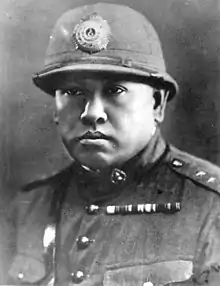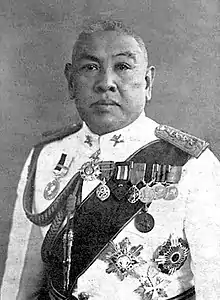1933 Siamese coup d'état
The Siamese coup d’état of June 1933 (Thai: รัฐประหาร 20 มิถุนายน พ.ศ. 2476) was considered the first time in Thai history that the military successfully overthrew the constitutional government. The coup took place peacefully on 20 June 1933 in Bangkok. The coup was led by Colonel Phraya Phahol Pholphayuhasena against the premiership of the Premier Phraya Manopakorn Nititada.[1] The coup was in effect a counter-coup against the dictatorial policies of Phraya Mano stemming from the Yellow cover dossier crisis.

Background

On 24 June 1932, the Khana Ratsadon ('People's Party') carried out a peaceful revolution against the rule of King Prajadhipok (Rama VII) the absolute monarch of Siam. The party forced the King to give up his absolute powers and gave the Siamese people their first written constitution. On 10 December 1932, a "permanent" charter was promulgated with the blessings of the new constitutional monarch.
The constitution stripped the king of most of his powers, to be exercised instead by the new Government of Siam, which included the People's Assembly (Thai: สภาผู้แทนราษฎร) (the legislature), the People's Committee (Thai: คณะกรรมการราษฎร), (the executive), and the Supreme Court, (the judiciary) (Thai: ศาลฎีกา). The president of this new assemblage would be the head of government and in de facto Prime Minister of Siam. The role was offered and accepted by the 48 year-old former Minister of Justice, Privy Councillor and Middle Temple lawyer Phraya Manopakorn Nititada. His title was later changed to prime minister as the old title was deemed too communistic. Phraya Mano was considered at the time the least controversial choice for the post of prime minister due to his lack of conflict, his neutrality, and whose hands were deemed the "cleanest".
The Yellow Cover Dossier
The new People's Committee (the government) was made up of 20 ministers of state, 10 of whom came from the People's Party while the 10 others, high ranking civil servants, were picked by the party. The committee quickly turned dictatorial. On 15 March 1933 Pridi Phanomyong, one of the founding members of the People's Party, a revolutionary, and member of the People's Committee and minister of state submitted to the People's Assembly a "Draft National Economic Plan", the so-called "Yellow Cover Dossier" (Thai: สมุดปกเหลือง).
The dossier outlined Pridi's plan for the country including an overhaul of the county's economic, financial, and social structure. This ambitious plan would try to revise 700 years of feudalism in Siam. In his own words he wrote, "...this change of administration is not merely a coup d'état but an economic revolution". In section 1 of the economic plan he wrote:
.jpg.webp)
I remain resolute on this subject, and am of the view that if the government devises an appropriate national economic plan, finding employment for every citizen will not be beyond us. The improvement of the people's welfare is one of the primary goals in the reform of the system. Never was there an intention to transform the political system from a monarchy to an oligarchy, which would attempt to be a democracy in name only. I focused on the substance, namely, nourishing the welfare of the people. The constitution became the key to open the door of opportunity for the ordinary people to have a voice in the country's administration according to their needs and aspirations. Once this door has been opened, it is the duty of the government to lead the people through this door into a new land of prosperity.
Pridi tried to further his objective by suggesting reforms deemed socialist: national welfare, the redistribution of wealth and land to the poor, government guided economy, subsidies for rural farmers, a progressive taxation system, and social assurance and security for the poor. Pridi realised this and argued that these suggestions were merely a means to raise the standard of living of the rural poor. He further argued that, "Those who read the economic plan with a negative frame of mind would conclude that the government's attempt to run the economic system would de-humanise peoples into animals...I took great caution to prevent such de-humanisation; on the contrary, my desire was to help make people more human by eliminating the dangers to personal welfare brought about by economic factors...."
Despite its socialist leanings the dossier was a mix of both liberalism and socialism. For instance, the plan guaranteed the right of private property (in sections 1 and 5). The plan also called for the establishment of an independent central bank, both components of a liberal economic system.
Backlash
The plan drew criticism upon publication, including from newspapers, intellectuals stoked mostly by the urban elites, and landed nobility under the newly formed Khana Chart (Thai: คณะชาติ) ('National Party'), seeking a way to discredit the People's Party. The criticism centred on the socialistic nature of the dossier, including charges of communism and charges that Pridi was instigating a social revolution. The criticisms were also aimed at Phraya Mano, who allowed Pridi to publish the plan. Despite these charges the People's Party and especially the young revolutionaries and most of the urban middle class and rural poor stood behind Pridi. The debate, however, exploded into a constitutional crisis when King Prajadhipok, who had confessed to the nation that he had little knowledge of financial affairs, attacked Pridi verbally and asked whether Pridi copied his plans from Joseph Stalin or Stalin from Pridi's.
The controversial and harsh royal intervention drew even more outrage from the public, this time not directed at Pridi but at the king. For the monarch had violated the constitution and was in effect criticising his own constitutional government. This led to a lawsuit by Mr. Thawan Ritthidet, a civilian suing the monarch on the grounds he violated the constitution by interfering in political affairs.
Constitutional crisis and silent coup
The People's Committee was split between those who supported Pridi and those who opposed him, led by Phraya Mano himself. He by now had realised the danger of Pridi's plans. On one side were the revolutionaries and members of the People's Party. On the other were civil servants and some elite members of the military, and former revolutionaries, among them Phraya Songsuradet, Phraya Ritthi Akhaney, and Phra Prasan Pithayayut. These men threatened Pridi and his supporters, stating that they would carry weapons into the assembly. When Pridi did not attend the session they surrounded Pridi's house with armed supporters.
Phraya Mano had little choice and was forced to call for the dissolution of the People's Assembly on 1 April 1933. Under emergency decree some parts of the constitution, including the legislature and the judiciary, were suspended. On 2 April, the government repealed the "Anti-Communist Act", which gave the police executive powers to arrest without trial citizens who are considered to be communists. Under this law the People's Party was disbanded. The Communist Party of Siam's central committee was arrested as well as numerous others including Vietnamese exiles accused of having communist sympathies. Left wing newspapers and publications were suppressed. This series of events is called the "silent coup" (Thai: รัฐประหาร 1 เมษายน พ.ศ. 2476) and is considered by many Thai historians as the first "real" coup d'état instigated by the military in Thailand against a constitutional government. On 12 April 1933, Pridi was exiled to France.
The coup

On 15 June, Army Colonel Phraya Phahol Pholphayuhasena (or Phot Phahonyothin), a member of the People's Party and a minister of state resigned from his seat on the People's Committee, citing health reasons. In fact he and Naval Commander Luang Supphachalasai, with the help of young military officers, were conspiring to overthrow Phraya Mano's government. With the support of the army, the navy, civilian factions within the People's Party, and the support of most of Bangkok's populace, Phraya Phahol was able to act.
On 20 June Phraya Phahol and Luang Supachalasai, seized the National Assembly building and proclaimed themselves as the legitimate government. Citing the fact that the present government has acted illegally in dissolving the assembly and that they would return the constitution, which the previous administration had suspended. Phraya Phahol appointed himself the country's second prime minister and Luang Supachalasai a minister of state. He immediately recalled the People's Assembly and asked the Speaker to submit to King Prajadhipok at the Klai Kangwon Palace in Hua Hin, the reasons for the coup. The King duly accepted. He also pardoned Pridi and recalled him from exile.
Immediate resistance to the coup was limited and quickly dissolved as Phraya Mano resigned and escaped the capital by rail to Penang (then part of British Malaya), where he died in 1948. Phraya Songsuradet and others were barred from entering politics. This would eventually result in the Songsuradet Rebellion in 1939.
Aftermath and legacy
The coup was the first (many would follow in subsequent years) that was successfully carried out by the military against a civilian government. Though bloodless, the coup was the start of a dictatorial regime worse than the one that it had replaced.
Pridi Phanomyong eventually returned to Siam on 29 September 1933, but not returning to government immediately. He became an academic and founder of Thammasat University in 1934. He would eventually become one of the most important players in Thai history. During the Second World War he became Regent of Thailand (1944–1946) and Prime Minister of Thailand in 1946. However, the label of communist would never leave him. Many issues, chiefly those concerning the role of Prajadhipok, were never resolved and would eventually lead to the Boworadet Rebellion later that year.
References
- "Thailand coup: A brief history of past military coups". The Washington Post. 22 May 2014. Retrieved 29 December 2019 – via The Straits Times.